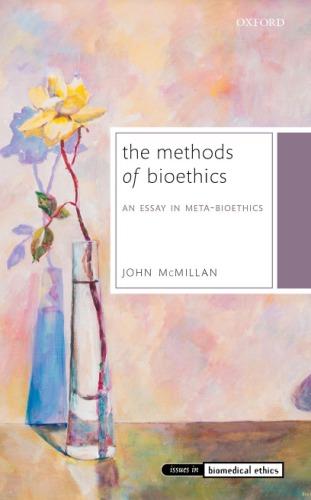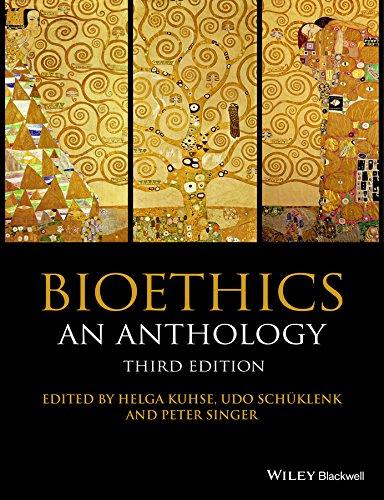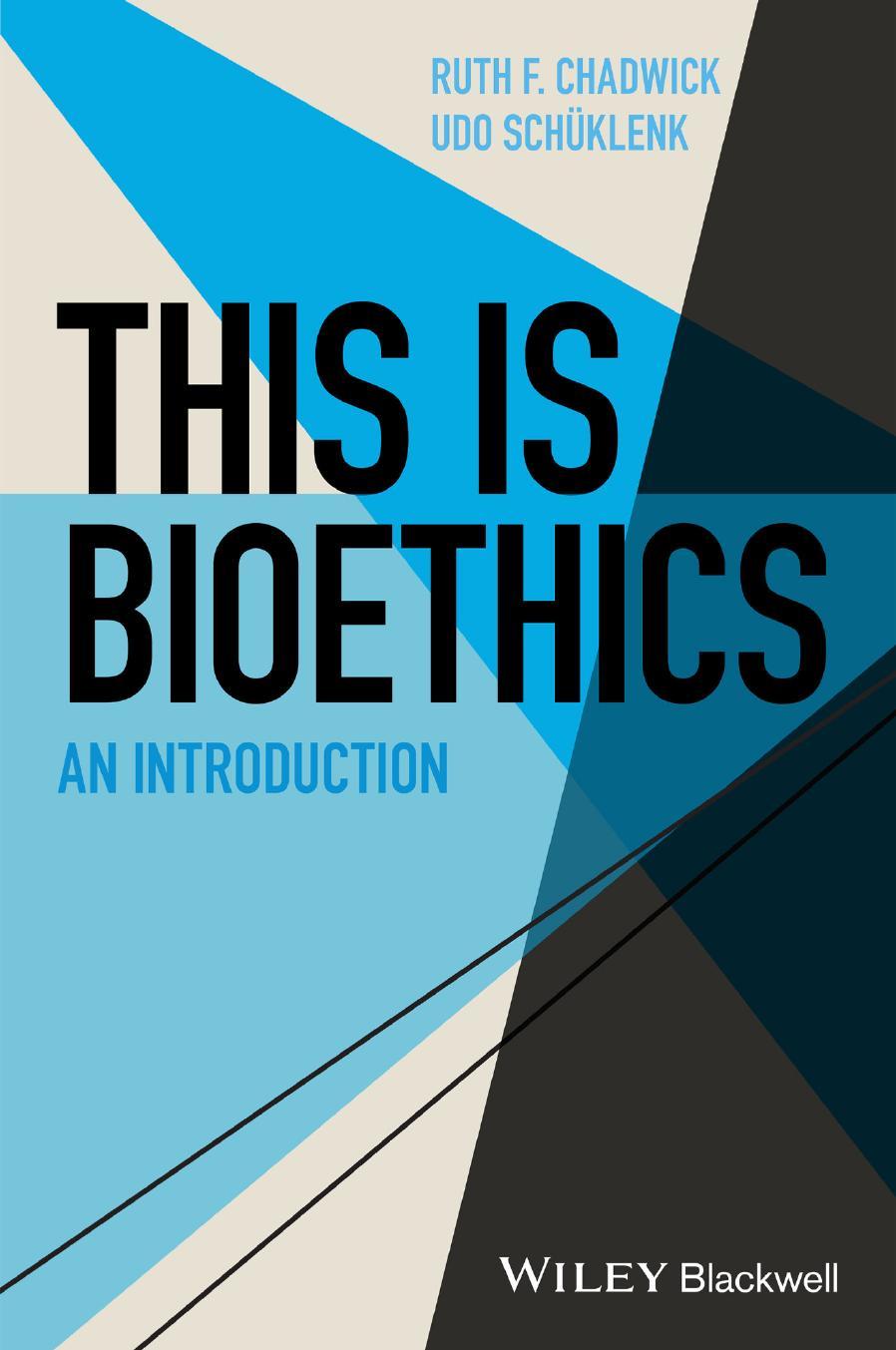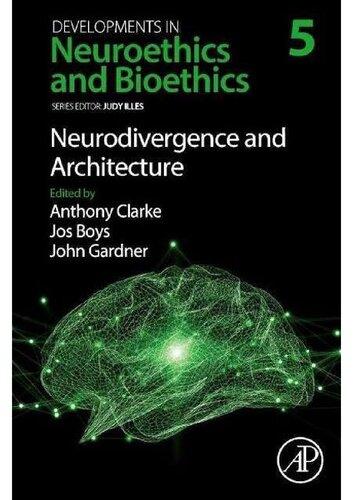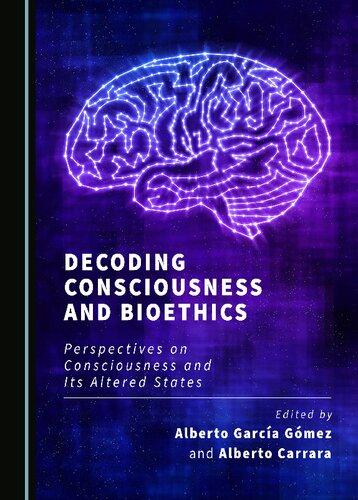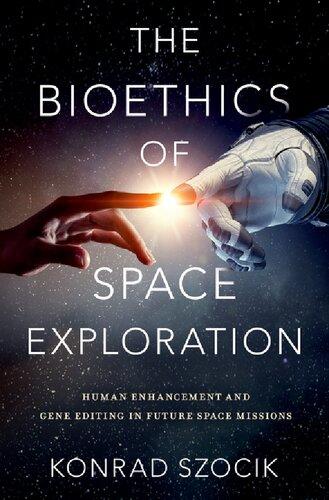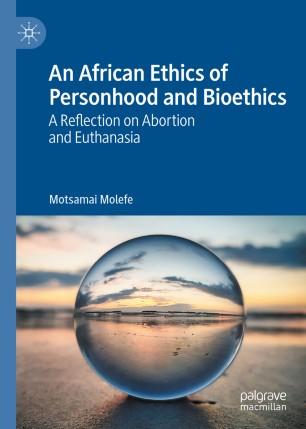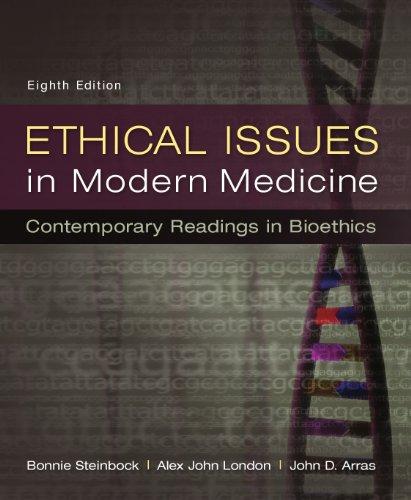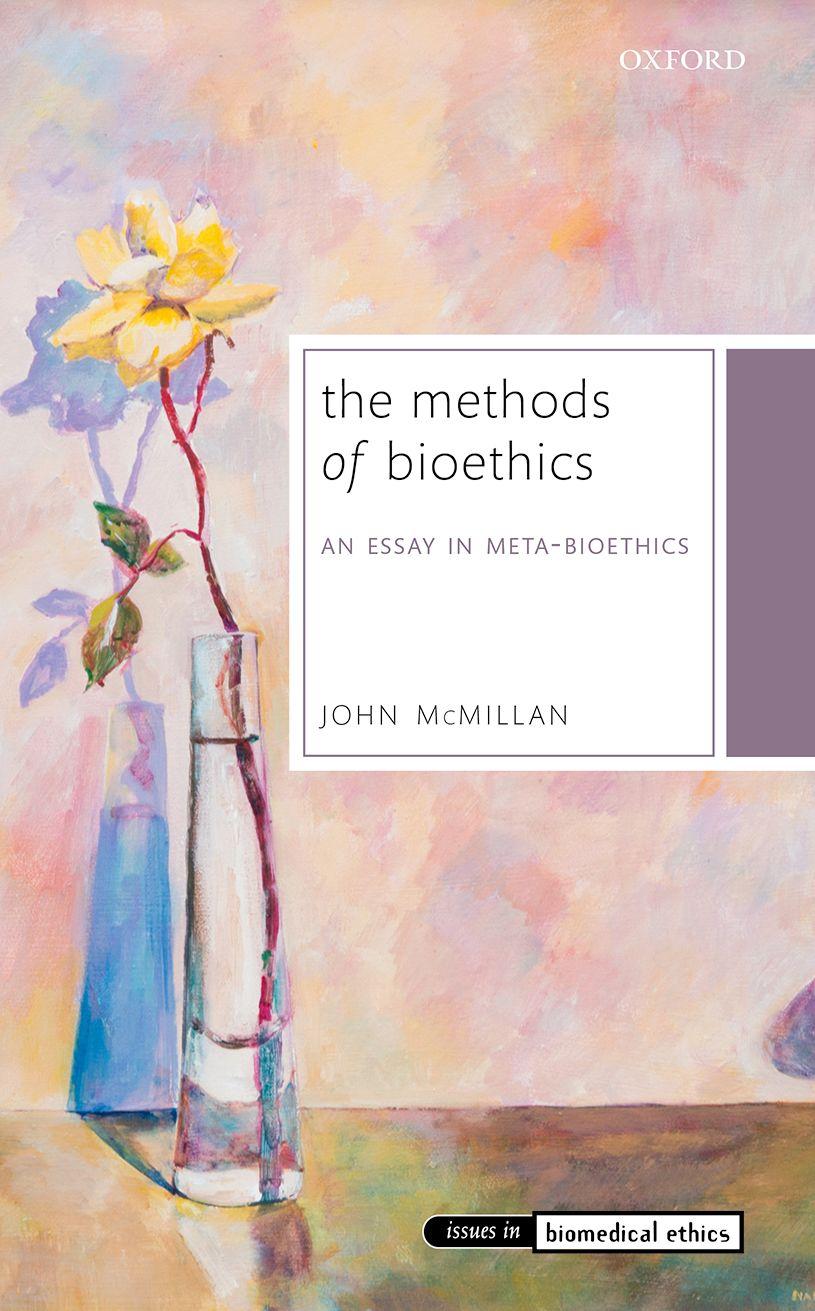The Methods of Bioethics: An Essay in Meta-Bioethics John Mcmillan Visit to download the full and correct content document: https://ebookmass.com/product/the-methods-of-bioethics-an-essay-in-meta-bioethicsjohn-mcmillan/
More products digital (pdf, epub, mobi) instant download maybe you interests ...
Bioethics: An Anthology (Blackwell Philosophy Anthologies) 3rd Edition, (Ebook PDF)
https://ebookmass.com/product/bioethics-an-anthology-blackwellphilosophy-anthologies-3rd-edition-ebook-pdf/
This Is Bioethics: An Introduction Ruth F. Chadwick & Udo Schuklenk [Chadwick
https://ebookmass.com/product/this-is-bioethics-an-introductionruth-f-chadwick-udo-schuklenk-chadwick/
Neuroethics and Bioethics: Neurodivergence and Architecture Anthony Clarke
https://ebookmass.com/product/neuroethics-and-bioethicsneurodivergence-and-architecture-anthony-clarke/
Decoding Consciousness and Bioethics 1st Edition Alberto García Gómez
https://ebookmass.com/product/decoding-consciousness-andbioethics-1st-edition-alberto-garcia-gomez/
The Bioethics of Space Exploration: Human Enhancement and Gene Editing in Future Space Missions Konrad Szocik
https://ebookmass.com/product/the-bioethics-of-space-explorationhuman-enhancement-and-gene-editing-in-future-space-missionskonrad-szocik/
An Essay Concerning Human Understanding John Locke
https://ebookmass.com/product/an-essay-concerning-humanunderstanding-john-locke/
An African Ethics of Personhood and Bioethics: A Reflection on Abortion and Euthanasia 1st ed. Edition Motsamai Molefe
https://ebookmass.com/product/an-african-ethics-of-personhoodand-bioethics-a-reflection-on-abortion-and-euthanasia-1st-ededition-motsamai-molefe/
Ethical Issues in Modern Medicine: Contemporary Readings in Bioethics, 8th edition 8th Edition, (Ebook PDF)
https://ebookmass.com/product/ethical-issues-in-modern-medicinecontemporary-readings-in-bioethics-8th-edition-8th-edition-ebookpdf/
Moral Realities: Mormonism, Medicine, and Bioethics 1st Edition Courtney S Campbell
https://ebookmass.com/product/moral-realities-mormonism-medicineand-bioethics-1st-edition-courtney-s-campbell/
TheMethodsofBioethics ISSUESINBIOMEDICALETHICS GeneralEditors
JohnHarrisandSørenHolm
ConsultingEditors
RanaanGillonandBonnieSteinbock
Thelatetwentiethcenturyhaswitnesseddramatictechnologicaldevelopmentsinbiomedicalscienceandthedeliveryofhealthcare,andthese developmentshavebroughtwiththemimportantsocialchanges.Alltoo oftenethicalanalysishaslaggedbehindthesechanges.Thepurposeofthis seriesistoprovidelively,up-to-date,andauthoritativestudiesforthe increasinglylargeanddiversereadershipconcernedwithissuesinbiomedicalethics notjusthealthcaretraineesandprofessionals,butalsophilosophers,socialscientists,lawyers,socialworkers,andlegislators.Theseries featuresbothsingle-authorandmulti-authorbooks,shortandaccessible enoughtobewidelyread,eachofthemfocusedonanissueofoutstanding currentimportanceandinterest.Philosophers,doctors,andlawyersfroma numberofcountriesfeatureamongtheauthorslinedupfortheseries.
TheMethods ofBioethics AnEssayinMeta-Bioethics
JohnMcMillan
GreatClarendonStreet,Oxford,OX26DP, UnitedKingdom
OxfordUniversityPressisadepartmentoftheUniversityofOxford. ItfurtherstheUniversity’sobjectiveofexcellenceinresearch,scholarship, andeducationbypublishingworldwide.Oxfordisaregisteredtrademarkof OxfordUniversityPressintheUKandincertainothercountries ©JohnMcMillan2018
Themoralrightsoftheauthorhavebeenasserted
FirstEditionpublishedin2018
Impression:1
Allrightsreserved.Nopartofthispublicationmaybereproduced,storedin aretrievalsystem,ortransmitted,inanyformorbyanymeans,withoutthe priorpermissioninwritingofOxfordUniversityPress,orasexpresslypermitted bylaw,bylicenceorundertermsagreedwiththeappropriatereprographics rightsorganization.Enquiriesconcerningreproductionoutsidethescopeofthe aboveshouldbesenttotheRightsDepartment,OxfordUniversityPress,atthe addressabove
Youmustnotcirculatethisworkinanyotherform andyoumustimposethissameconditiononanyacquirer
PublishedintheUnitedStatesofAmericabyOxfordUniversityPress 198MadisonAvenue,NewYork,NY10016,UnitedStatesofAmerica
BritishLibraryCataloguinginPublicationData
Dataavailable
LibraryofCongressControlNumber:2018947647
ISBN978–0–19–960375–6
PrintedandboundinGreatBritainby ClaysLtd,ElcografS.p.A.
LinkstothirdpartywebsitesareprovidedbyOxfordingoodfaithand forinformationonly.Oxforddisclaimsanyresponsibilityforthematerials containedinanythirdpartywebsitereferencedinthiswork.
PartIII.TheMethodsofBioethics Acknowledgements OverthecourseofseveralyearsAdrianWalshandIhavediscussed theimportanceofargumentforbioethics,andhowthereseemstobe anoveremphasisontheory,andanumberofthenamesthatIhave giventopartsofthisbookaroseoutofdiscussionsI’vehadwith Adrian.Theideathatweshouldviewtheobstaclestogoodbioethics as ‘spectres’ ishis,anditdescribeswellthewayinwhichanumberof historicalissuescontinuetohauntbioethics.Itwashisideathatwe canthinkofthetwobroadclassesofstrategyusedinethicalreasoning as ‘speculation’ and ‘drawingdistinctions’,andthissuggestion,aswell asmanyothershehasmade,helpedtoshapethisbookintotheform itnowhas.Frommy firstinteractionswithbioethicsIwasawarethat thisisanareawhereadegreeofhumilityisrequired:ifyoucome fromaphilosophical,legal,orsociologicalbackgroundyoushouldbe awareoftheexpertisethatothersbringtoethics,especiallyina clinicalcontext.Adriansuggestedthatthebestdescriptionforthis conceptis ‘epistemichumility’;Ihavedevelopedthatidea,andit playsanimportantroleintheargumentofthisbook.
I’mindebtedtoJulieMcMillan-Kearns,BruceMcMillan,and ThomasineKushnerforinvaluablecommentsondraftsofthismaterial. ThetwoanonymousreviewerswhoreadthisbookforOxford UniversityPressmadeanumberofinsightfulcommentsandspotted gapsintheargument.Thisbookismuchimprovedasaresultoftheir efforts.Otherswhohavemadeparticularlypenetratingandinsightful commentsinclude:TonyHope,JulianSavulescu,TomDouglas, MarkSheehan,MikeyDunn,andMikeParker.
Whenthinkingthroughthestructureandclaimsofthisbook, IwasfortunatetogiveseminarsatTheUehiroCentreforPractical EthicsandtheEthoxCenterattheUniversityofOxford.Ialsogavea talkbaseduponthisbookatthe2017 InternationalBioethicsRetreat inParis.Anumberofpeoplewhowerepresentattheconsortium
madesuggestionsorraisedobjectionsthathavebeenhelpfulin refiningthisbook.
LynleyAnderson,PeterCrampton.andmycolleaguesatthe BioethicsCentremadeitpossibleformetotakeresearchleaveand completethisbook,andIamgratefulfortheircollegialityand support.
Butmostofall,Iamgratefulforthewarmthandjoythatisbeing withJulie,Isabel,James,andKatie,whosustainedmethroughthe challengesof2016and2017.
JohnMcMillan
1 HowtoFindYourFooting inBioethics Myintroductiontobioethicswasinthemiddleofthe1990s,and Istartedinthisnewareaanimatedand filledwithzealbecausemy philosophicalstudieswereabouttotakeaturnforthepragmatic.No longerwouldmyeffortstograspthemeaningofdifficultpassages inWittgensteinorKantmerelybeaboutthepursuitofknowledge, Iwasabouttoembarkuponanoceanofissuesthatreallymatter. So,IwaspuzzledwhenIventuredintothebioethicsliteratureofthat time,to findthatthepredominantissuesweretodowiththeory.And notjustanytheory,moralprinciples!Thisdidnotsitatallwellwith theintellectualdietofpossible-worldsemantics,functionalism,and moralnihilismthatIhadbeennurturedon.Thiswasn’tjustasense thatthiswasamuchmoreoptimisticviewabouttheprospectsfor moraltheorythanIhadseenbefore,itwasasenseofsurprisethatthe excitingneon-litdilemmasthatIheardaboutwerenottakingup everyone ’stime.Itwasasiftheattentionofthoseworkingwithin bioethicshadbeendirectedatsomethingthatwasnotinthecentreof thepainting,creatingtheunsettlingfeelingthatwhatshouldbe centraltoourattentionwasbeingoverlooked.
Whilebioethicshasmovedon,andmuchlesseffortisexerted arguingaboutwhetherthereshouldbeone,three,four,orseven principlesforbioethics,thefeelingthatsomehowbioethicshas missedtheethicalwoodsforthetheoreticaltreeshasnotleftme. Theorybuildingisnotasgrandnow,andthereislessofit.Nonetheless, everyyearbooksappearthatdescribeanewtheoreticalperspective
uponbioethics,alongwitheditedcollectionstiedtogetherwiththe promiseofadistinctiveinsightintothenatureofethicalissues.The tendencyforintroductionstobeginwithsummariesofthemajor moraltheories,andthensaysomethingaboutprinciples,persists, andthisbookarosefromtheconvictionthatwe’veallmissedan importantpointabouthowitiswedobioethics.Thatistheideabehind thisbeinganessayin ‘meta-bioethics’:itinvolvestakingastepback frombioethicsandthinkingaboutwhatwearereallyaimingtodo,and howinfactwegoaboutdoingitwell.
Mysecond,andperhapsmoreimportant,motivationisthatovera periodoftwentyyearsIhaveseenaseriesofnewcomerstobioethics struggleto figureoutwhatthisenterprisereallyis,andhowyougo aboutdoingit.Manyofthesepeoplehavecomefrommedicineand otherhealthprofessions,andI’veoftenfeltasourceoffrustrationat watchingthempushverysensibleclinicalethicalthoughtsthrough crudeparaphrasingofwhatMill,Kant,orAristotlewouldsayabout thatsituation.Thatisnottosaythatthosefromnon-philosophical backgroundsshouldbeprotectedfromhistory’sgreatthinkers,just thatsettingmoraltheoryupassomethingthatisgoingtohelpgetyou startedinbioethicsoftenleadsverycleverpeopleastraywhenthere aremuchmoreusefulthingsthatcouldbesaidtohelpthem.
Thesetwomotivatingreasonsmeanthatthisbookhasbeenwritten forreaderswithtwodifferentneeds:thosenewtobioethicsand lookingforthequickestwaytogetstarted,andthosenotsonewto bioethicswhoareinterestedinitsnature,purpose,andfuture.
Bioethicshasmadeamistakeaboutwhatitsmethodsare,andthis haslednotonlytotoomuchtheorizingbutalsotofragmentation withinbioethics.Theunhelpfuldisputesbetweenthosewhothink bioethicsneedstobemorephilosophical,moresociological,more clinical,ormoreempiricalcontinue.Whileeachoftheseclaimswill have some point,theyobscurewhatshouldbecommontoallinstances ofbioethics.Moreover,theyprovideanotherphantomthatcanlead newcomerstobioethicsdownblindalleywaysstalkedbybristling sociologistsandphilosophers.Themethodcommontoallbioethics isbringingmoralreasontobearuponethicalissues,anditismore
accurateandproductivetoclarifywhatthisinvolvesthantostake outamethodologicalpatchthatshowswhyonedisciplineisthe mostimportant.Forthosewhoareinterestedintheseissues,Parts I,II,andIIIofthisbookpresentacharacterizationofwhatItaketobe thenatureofbioethics,adiscussionofmethodologicalspectresthat areobstaclestobioethicsbeingwhatitshould,andthenchapters discussingthemethodsofbioethics.
Thosewhohavebeenaskedtowritetheir firstessayinbioethics,or perhapshavebeenco-optedtowriteapaperonbioethics,canskip directlytoPartIIIofthisbook.Chapter7isagoodplacetostartif youwantanintroductiontohowyoubegininbioethics.Fromthere on,Chapters8,9,and10addfurtherstrategiesandmethodological bellsandwhistles.
Thisbookdoesnotdiscussempiricalethicsindepth,norother empiricalmethodsthatcanbeusedinbioethics.Thatisnotbecause Ithinkthey’reunimportant myviewisthateveryonewhoclaimsto haveexpertiseinthisareashouldhavesomefamiliaritywithhow suchmethodsworkandareimportantforgoodbioethics.Myreason fornotdiscussingthemisbecausetherearemanyothergoodbooks thatintroducethesemethodswell,andnobooksthatIamawareof thatdiscusshowitisthatthatyouargueaboutbioethics,whichisthe basicandgeneralmethodologicalskill.
PartIofthisbookoffersacharacterizationofwhatbioethicsis. Thisisimportantformycentralargument,astheconceptionof bioethicsasanissue-drivenareainvolvesbringingmoralreasonto bearuponethicalissues,explainswhythespectresdescribedin PartIIareproblems,andistheargumentforthemethodsdescribed inPartIII.
Moralreasonisnotsomuchathing,comparabletoabodyof knowledge;itisanactivityinwhichavarietyoftechniquesareusedto worktowardthebestjustifiednormativepositionaboutanissue. Issue-drivenmoralreasonisfrustratedwhenbioethicsoverplaysthe significanceofnormativemoraltheoryinreachingwell-grounded ethicalpositions.Thatisnottosaythatnormativemoraltheories havenopoint,noreventhattheyhavenovalueforbioethics;buttheir
valueisnotwhatitiscommonlytakentobeinbioethics,anditwould bemuchbettertofocusuponhowweinfactargue.
Bioethicsdoesnotonlyrequireustoarguewell;wemustalso engagewithissuesthatmatterandattempttoreachconclusionsthat arepracticallynormative.Thismeansthatwemuststraddlethe conceptualandtheempirical.Wemustbephilosophicalinthe Socraticsenseofposingquestions,imaginingpossibilities,anddrawingdistinctions,andempiricistsinthesensethatweeitheruse empiricalmethodsor findsomewayofgroundingouranalysisin theissuesthatmatter.Armchairethicscanfailtoengagewithreality andbepracticallynormative,whilemeaningful,issue-drivenbioethicsrequiressomesophisticationinconceptualapproaches.
Thecomplexityofbioethicsandtherapiddevelopmentoftechnologiesisareasonwhyepistemichumilityisimportant:wemustbe rigorousandbuildthebestcasethatwecanforourethicalpositions but,indoingso,bemindfulthatthereisagoodchancethatwehave missedsomethingofimportance thatwhatseemsvitaltodaymight notbethatwaytomorrow,andmostofall,thattheissueswediscuss canbedeeplyimportantforotherpeople’slives.
Thegoodnewsisthatmanypowerfulargumentativestrategiesare simpleandclosetothewaythatwereasoneveryday.Bygraspinga fewofthesebasicskillsinargument,newcomerstothisareacandraw uponpriorexpertiseanddogoodbioethicswithoutmasteryof normativemoraltheory.
PARTI Bioethics 2 WhatIsBioethics? TheOriginsofBioethics AccordingtoDanCallahan,bioethics hasitsoriginsinthetechnological developmentsofthe1960s(Callahan2004:279).Hedescribeshow newmedicaltechniquessuchaskidneydialysis,organtransplantation,prenataltesting,contraception,andintensivecarecreateda needforthecarefulanalysisofprofoundmoralissues.Interestingly, healsothinksthattheseadvancescoincidedwitharenewedinterest innormativeandappliedethicswithinphilosophy,feminism,and thecivilrightsmovement.Plausibly,hedescribeshowtheseevents togetherledtoanenvironmentwherearenewedemphasisuponselfdeterminationandscholarlyinquiryintotheethicalissuespresented bynewtechnologiescould flourish.
Anothercatalystforthecreationandprominenceofbioethicsis moralcrisis.Legalwranglesoverwho(ifanyone)couldauthorizethe withdrawalofartificialnutritionandhydrationfromcomatose patientsinthe1970sand1980sledtopublicinterestandaneedfor ethicalguidanceforsuchcases(Powledge1975).Whistle-blowing publications,suchasHenryBeecher’sbrilliantandbrave Ethicsand ClinicalResearch,raisedconsciousnessabouttheethicsofresearch, andcastashadowovertheassumptionthatphysicianswouldalways conductresearchinanethicalfashion(Beecher1966).Sentinelevents suchastheTuskegeeSyphilisStudy inwhichAfricanAmerican menwithsyphiliswerenottreatedwithpenicillin,sothatthenatural progressionoftheirillnesscouldbefollowed(Reverby2001) led tothecreationofsafeguardsforthosetakingpartinresearch,and
toimportantstatementssuchastheBelmontReport(National CommissionfortheProtectionofHumanSubjectsofBiomedical andBehaviouralResearch1978).
MoralcrisiswasalsoacatalystforbioethicsinBritain.While Beecher’ srevelationsofunethicalresearchruffledfeatherson onesideoftheAtlantic,MauricePappworth’sdiscussionofmany ofthesameresearchstudieshadlessimpactupontheBritishestablishment,butwasinfluentialforthosewhohelpedbioethicsin thatcountry(Pappworth1967;1991).Severalyearslater,thecollectionofinfantbodies,hearts,andbodypartsatLiverpool’ sAlderhey Hospitalledtoaninquiryandtolegislativechanges(RoyalLiverpool Children’ sInquiry2001).Forthemedicalprofession,especially pathology,thiswasaneventthatgaveitsleaderscauseforsoulsearchingandreflectionuponthepersistenceofpaternalism(Hall 2001;Hunter2001).Itisbesttoviewtheeventsthatbringethics intopublicviewaspartofanongoingprocesswhereissuesare highlightedandsomeprogressmade.WhileAlderheyandother eventsaroundthattimesuchastheShipmaninquiry(Dyer2005) changedtheethicalandlegallandscapeofthatcountry,bioethics wasalreadywellestablishedbytha ttime.TheInstituteofMedical Ethics,whichprovedtobeveryin fl uentialuponBritishmedical schools,Britishprofessionalbodies,andinthecreationofthe JournalofMedicalEthics ,wasestablishedin1972,longbefore theseevents(Campbell2000).
InNewZealand,therevelationthatwomenhadtakenpartinan unapprovedresearchstudythatinvolvedsubjects,withouttheirconsent,undergoingunnecessarydiagnosticprocedureswhilenotbeing activelytreatedforacancerprecursor,wasacatalystforcallsto improveourunderstandingandteachingofethics(Committeeof InquiryintoAllegationsConcerningtheTreatmentofCervical CanceratNationalWomen’sHospital1988).Thatrecommendation spurredoninterestandthedevelopmentofbioethicsinNewZealand. Bioethicsisaglobalphenomenon,anditseemsreasonabletosuppose thatamoralcrisis,orperhapsjust ‘significantmoralconcerns’ of
somekind,haveplayedaroleintheemergenceofbioethicsinallthe countrieswhereitisestablished.
Ofcourse,interestinmedicalethicsandtheethicalissuespresented bytechnologicaladvancesoccurredmuchearlierthanthe1960s.The AmericanMedicalAssociation’ s firstcodeofethicswaspublishedin 1847(AmericanMedicalAssociation1847),andbuiltonearlierwork by figuressuchasThomasPercivalandJohnGregory(Percival1823; Fishman2015).High-qualityscholarshiponmedicallawandethics predatedthecreationofbioethics,andthereisnobetterexemplarthan theworkofCambridgelawyerGlanvilleWilliams(Williams1958).
Utopiananddystopianthinkingaboutnewtechnologiessuchas AssistedDonorInsemination(AID)predateandprefiguresimilar debatesinbioethics(McMillan2007).Someviewedthepossibilities createdbyAIDasanopportunitytoworktowardthebetterment ofhumanityandreviseourmoralbeliefsabouttherelationship betweenloveandprocreation(Muller1936;Brewer1935).Others viewedAIDasathreattovitallyimportantsocialinstitutions, suchasmarriageandtheimmoralityofinfidelity(Archbishopof Canterbury’sCommissiononArtificialInsemination1948).
Whatisdistinctiveaboutthelate1960sisthatinterestinethical issuesandrightsreachedamasssufficientforthecreationofa distinctinterdisciplinaryareaofinquiryintoethics.TheHastings Center(ofwhichCallahanisaco-founder)wasfromitsbeginnings aninstitutionthatintegratedtheinsightsofanumberofcognate disciplines.Whilephilosophytendstoviewappliedethicsasasubset ofmoralphilosophy,bioethicsisdistinctinthatithasalways includedlawyers,theologians,sociologists,anthropologists,andhistorians(Sugarman2010).
Whilethe ‘bio’ inbioethicsdoesn’tcapturetheinterdisciplinary natureofbioethics,itsinterdisciplinarynature,alongwiththeamount ofworkconductedonethicalissuesandtheemergenceofbioethicsasa distinctareaofinquiry,iswhatdistinguishesitfromappliedethics. Whatithasincommonwithappliedethicsisanemphasisupon attemptingtoprovideanswerstopracticalmoralquestions.
MyDefinitionofBioethics andWhatItNeedstoDo Anaccountofthemethodologyofany fieldmustbeginwithanaccount ofthe fielditself.Ahistorian,mathematician,orphysicistcouldnot describehowtheirdisciplineis,andshouldbedone,withoutanaccount ofwhatitis,andwhenitisdonewell.However,everyattempttodefine adisciplineisdifficultandlikelytoalienatesome.
Itisdifficultforanumberofreasons,includingthatscholars, understandably,haveatendencytoseetheirareaascentral,and alsotoviewsomeotherareaswithinadisciplineasperipheral. Whilescholarscanbeveryclearaboutwhattheydo,itseemsunlikely thatanydisciplinecouldbedefinedusingasetofnecessaryand sufficientconditionsthatimpliedwhensomethingis,orisnot, history,mathematics,orphysicsinanon-arbitraryway.
Anyattempttode fineadisciplinethatleadstosharplydefined boundariesthatrulesomeactivitiesinandsomeoutislikelyto causeannoyancebecauseitisalienating:itislikelytoimplythat somewhoviewthemselvesasworkingwithinadisciplineareruled outbythedefinition.Onthe flipside,therewillalsobethosewho findtheyhavebeencategorizedwithina field,andobjecttothat categorization.
Anaccountofthemethodsofadisciplinerequiresanaccountof thatdiscipline,butitdoesnotneedtobeadefinitionthatdemarcates allthatfallswithinandoutsideit.Whatisrequiredisanaccount thatilluminatesthecentralpurposes,nature,andaimsofan area.Suchanaccountcanexplainmoreusefullywhyitisimportant,forexample,thattheoreticalphysicistscandescribeempirical eventsthatwouldfalsifyorhelpcorroboratetheirtheory.Sothe followingcharacterizationofbioethicsshouldnotbereadasan attempttoclearlydemarcatebioethicsfromthatwhichfailstobe bioethics;rather,itsaimistoelucidatethenatureofbioethicsina mannersimilartohowtheOxfordProfessorofJurisprudence HerbertHartexplainedthenatureoflawin TheConceptofLaw (Hart1961).
TheEssenceofBioethics Itisunlikelythatadefinitionof ‘bioethics’ withnecessaryand sufficientconditionscouldsatisfyeveryone.Instead,Iwillfollow Hart’sstrategyin TheConceptofLaw (1961),andratherthanoffering a dere definitionofbioethicsthatgeneratesnecessaryandsufficient conditions,I’llarticulatethe essential aims,concerns,andfeaturesof bioethics.Hartclaimedthattheessenceoflawistheunionofprimary andsecondaryrules.Bythishemeantthattheessenceoflaw,or perhaps,the ‘heart’ oflaw,isthatitistheconjunctionofnormative legalrulesandrulesthatcreate,alter,orremoveprimaryrules.The unionofprimaryandsecondaryruleswillnotrefertoeveryinstance ofwhatweconsiderlaw,butthatisnotthepointofsuchadefinition. Hartintendstoilluminatethecoreorcentreofwhatlawreallyis,so astoilluminateitsnature.Thatkindofaccountissufficientfor describingthemethodsoflaw,oranotherarea.Inthefollowing sections,Iwilldevelopthatkindofaccountofbioethics anaccount thatwillhelptoarticulatewhatthemethodsofbioethicsare,and shouldbe.
Battin’sTrichotomyandClinicalConsultation MargaretBattiniswellplacedtocommentuponthenatureand developmentofbioethics.LikeDanCallahanandAlastairCampbell, sheisoneofthefoundationalthinkersinbioethicsandhasbeena leading figuresincethe1970s.Shehaswrittenextensivelyaboutcore issuessuchastheendoflifeandtherationingofhealthcare.In Battin’sview,bioethicshastendedtobedilemma-motivated:whena sharpmoralissueisidentifiedandcausesinterestandconcern,thenit becomesanissueforbioethics.1 Theemphasisuponaddressing pertinentpracticalissuesleadshertoconcludethatbioethicsinvolves ‘bringingmoralreasontobear’ uponpressing,practicalethicalissues.
1 TonyHopeandIalsoarguethatbioethicsshouldbeissue-ordilemma-driven inMcMillanandHope(2008:ch.2).
Theideathatpartofthe ‘ core ’ ofbioethicsis ‘bringingmoralreason tobear’ seemscorrect,andIwilldefendanddevelopthatidea.Within herobservationthatbioethicstendstoreacttopracticalandpressing issuesisanothercluetowhatseemstobecoreforbioethics,andis anotheraspectofbioethicsIwilldefendanddevelop.
Battinobservesthatbioethicsischaracterizedbythreerelatedbut distinguishableactivities,allofwhichinvolvebringingmoralreason tobearuponpracticalissuesandaredrivenbypressingissues:
theoreticalreflection,groundedinphilosophicalinquiry;clinicalconsultation,stemmingfromtheneedsofmedicine;andpolicydevelopment, proddedbylaw havebeendrivenfromthestartbydilemmaticcases.
(Battin2013:2)
EspeciallyintheUnitedStates,whereclinicalethicsconsultationis commoninhospitals,Battinthinksacoreactivityofbioethicsisto provideadviceaboutchallengingethicalissuesinclinicalcare.While beingabletoapplytheoreticalmoralconsiderationstopracticalissues islikelytoplayalimitedroleinclinicalethics,itrequiresasetof additionalskills,experiences,andattitudes.Clinicalethicsconsultationwillusuallyinvolvediscussingacomplexclinicalscenariowith clinicianswhoarespecialistsinthatareaofhealthcare.Thatimpliesa degreeofhumilityandoftenplayingmoreofamediatingrolethan actingasamoralexpert.Clinicalcasesusuallyinvolveacomplexand changingsetoffacts,andthistooimpliesadifferentapproachfroma morephilosophicalreflectionuponethics.Clinicalethicsconsultationalmostalwaysoccurswithinalegalandprofessionalcontext, andthosenormsarealsorelevanttoreachingasoundandjustified decisionaboutwhatshouldhappen.
WhileBattinchoosestheterm ‘clinicalconsultation’,itisclearthat shehassomethingbroaderinmindthanjustclinicalethics.She mentionsresearchethicsasanimportantareaofactivitywithinbioethics,andwhilethatisnotobviously ‘clinicalconsultation’,itisaway inwhichbioethicshelpstomeettheneedsofmedicine.Publichealth ethicsisagrowingandimportantspecialitywithinbioethics,andittoo isawayofmeetingtheneedsofmedicine.Iproposethatabetterterm thanclinicalconsultationis ‘biomedicalcaseconsultation’ .
Thatpreservesherobservationthatthereisanimportantdifference betweenadvisingabouttheethicsofaspecificcaseorissueand ascholarlyexplorationofthatclassofissue,typicallyinascholarly publication.
BioethicsandPublicPolicy Bioethicsaspolicydevelopmenthasitsownsetofextraattributes.As Battinobserves,lawisoftenascendantinpolicyworkbecausepolicy functionsinalaw-likewayandhastogeneraterulesthatwillwork overarangeofcases.Bringingmoralreasontobearuponpublic policyrequiresitsownskillsandexperience.Reasoningaboutthe ethicsofapolicyissueinvolvescontextualfeaturessuchasthelegal background;butitalsoshouldbesensitivetowhatispolitically feasible,whatislikelytoworkasageneralpolicyrecommendation, andwhatthepublicislikelytoaccept.
DanBrockservedonthePresident’sCommissionfortheStudyof EthicalProblemsinMedicine,andheobservedthatitwasnecessary totemperhowhewouldargueaboutanethicalproblem(Brock 1987).Asaphilosopher,hewoulduseevidenceandargumentinan attempttoreachthetruth.However,hefound,whenarguingthat thereisnomoraldifferencebetweenkillingandlettingdie,thatwhen hesucceededinconvincingpolicymakersofthisposition,itresulted intheirstartingtoentertainpolicythatwouldhavehadharmful consequences.So,philosophersandbioethicistscontributingtothe shapingofpublicpolicyshouldalsobewhatBrockcalls ‘moral consequentialists’:theyshouldbesensitivetothemoralimplications ofanethicalviewbeingenactedasamatterofpolicy.
Brockisrightthatpolicyworkrequires ‘moralconsequentialism’ , andthisalsoimpliesbeingawareofwhereapolicymakingbodyis located,itsfunctionandwhatitcanrealisticallyachieve.Thereare occasionswhereanethicalargumentshouldbetailoredsothatit supportsthebestoptionthatislikelytobesupportedorfundedbya governmentalagency.
Supposethatthereisamethodofscreeningforbowelcancerthat wouldbetheoptimalmethodofscreening,inthatitisefficientat
detectingcanceratanearlystageandithasfewfalsepositives,so minimizesharmtothosewhohaveinvasivediagnostictestswhen theydonothaveearlybowelcancer.Supposealsothatthisprogrammeisveryexpensive,andpolicymakerscanreliablypredict thatthepubliclyfundedhealthcaresystemdoesnothavesufficient fundingtosupportit.Thereisavariantmethodofbowelscreening thatiseffectiveatdetectingearlybowelcancerandwillthereby generatesimilarhealthgainstothosewhoareintheearlystagesof cancer.Supposethatthisalternativemethodischeaperandhasa goodchanceofbeingfundedifthebioethicistarguesstronglyinits favour.Thedrawbackwiththecheapermethodisthatithasahigher rateoffalsepositives,whichwillmeanthatmorepeoplewhodonot haveearlycanceraregivenacolonoscopy(thepreferreddiagnostic techniqueforbowelcancer).2
Thebioethicistmightreasonthattheexpensiveandmoreaccurate screeningmethodispreferable,becausefewerwellpeoplewillbe harmed,andthatthisistheoptionthattheyshouldsupportbeing funded.However,iftheydoso,itmightbethatneitherprogrammeis fundedandbowelcancerisdetectedlaterinalargenumberofpeople. Thisisanexampleofmoralconsequentialism:althoughthebioethicistmighthavegoodmoralreasonsforarguingthatthemoreexpensivescreeningprogrammeismoreethical,insodoing,sherunsthe riskofcausingharm.Inthiskindofcase,abioethicisthastobe knowledgeableabouttheroleofthepolicygroupofwhichsheisa member,bewellbriefedaboutthepracticalrealitiesofwhatis achievable,andbeawareoftherisksofarguingstronglyforthebest attheexpenseofthegood.
Itisworthnotingthatmoralconsequentialismisafeatureof biomedicalcaseconsultationtoo,inthatgreatsensitivitytotheconsequencesthatmoralrecommendationscanhaveisimportant.That couldbebecauseaclinicianendsupdoingsomethingthatwascontrary
2 Colonoscopyisanunpleasant,albeitveryeffective,techniquethatinvolves insertingalong flexibleinstrumentwithacameraintothebowelsotheinterior surfacescanbeexamined.
totheirbetterjudgement,oritcouldalsobethatarecommendation contradictswhatotherhealthcareprofessionalsthinkaboutthatissue. Forexample,anobstetricianseekingclinicaladvicemighthavea differentsetofprioritiesfromamidwife,andcareneedstobetaken aboutthemoralconsequencesofadvicethattakesanegativeviewof anotherprofessionalgroup.
ScholarlyBioethics Theoreticalreflection,groundedinphilosophicalinquiryisthemost obviouslyphilosophicalofBattin’sthreecoreactivities.WhileIagree thatthereisathirdbroadareaofthiskind,itisbettertothinkofitas ‘scholarlybioethics’.Bioethicspublicationsarelikelytobeinstances ofscholarlybioethics,asareconferencepresentationsandseminars. Therearetworeasonswhythischaracterizationofthemoreacademic partofbioethicsisbetter.The firstisthatphilosopherscanview themselvesastheonlypeopleequippedtotheorizeandreasonabout ethics(thisisaspectrediscussedinChapter4).So,itisimportant whencharacterizingbioethicstodoitinawaythatdoesnotleadto onedisciplinebeingdominant.AsecondspectreiswhatIcall ‘the ethicalsausagemachine’,anditoccurswhenatheoreticalperspective overdeterminesapracticalethicalrecommendation.AsIwillexplain, thishappenswhenbioethicsisdrivenbytheoryratherthanbymoral issues.WhileBattinthinksthatallareasofbioethicstendtobeissuedriven,itisimportantthatthethirdareaofbioethicsisnotidentified with ‘theoretical’ reflection,becausethisisnotwhatscholarlybioethicsdoes,norshoulddo.
Scholarlybioethicshasalessstrictfocusuponprovidingtentative moralconclusionstopracticalethicalissues.Inadditiontobeingless restrictedinitsmoralrecommendations,bioethicsandscholarly inquirycanbemuchmorespeculativeabouttheissuesitconsiders. Whilebiomedicalcaseconsultationusuallyinvolves findingaway forwardwithacase,andpublicpolicyusuallyinvolvesguidanceon policyquestions,scholarlybioethicscanspeculateaboutourmoral thinkingonasyetundiscoveredtechnologies.
Theenhancementdebaterehearseshowweshouldapproachnew technologiesthatenablehumanbeingstoimprovetheircognitiveand physicalabilitiesbeyondthenormalrange(SavulescuandBostrom2009; PerssonandSavulescu2012).Ofcourse,questionscanbeaskedabout whethertheamountofscholarshipdirectedathypotheticalfuturesis excessive,butitcanbedefendedinwaysinwhichasimilardegreeof speculationcouldnotinaclinicalethicsorpublicpolicy-setting.
MoralReason Battin’sobservationthatthecoreofbioethicsinvolves ‘bringing moralreasontobear’ isimportantandneedsfurtherelaboration. Giventhattheterm ‘bioethics’ literallymeans ‘lifeorliving’ ethics,it hastoinvolvethemoralityoflifeorlivingthings.Herphrase ‘bringingtobear’ iswellchosenbecause ‘applying’ mightbetakentoimply thatitinvolvesoverlayingapre-existingmoralframeworkuponaset ofissues.AsIwilldemonstratethroughoutthebook,itismuchbetter toviewmoralreasonasaprocesswherebypracticalmoralissuesand relevantfactsareteasedoutandthenconsideredinareflective, normativeargument.
FornowIwillofferapreliminarydescriptionofmoralreason thatwillbedevelopedinthisbook.Oneaspectofmoralreasonis thatitattemptstoclarifythenatureofthepracticalandmoral considerationsrelevanttoanissue.Thenallrelevantconsiderations aresubjectedtoacriticalprocessinwhichclaimsaretestedfor theirtruthandinferencesfortheirvalidity.Onewayofdoingthis (whichIwilldiscussatthebeginningofPartIII)isbycreating syllogisms.Whilethatprocessusuallydoesnotoccurexplicitlyin bioethics,ordinarilyitshouldbepresentimplicitlywithinallthe threemainareasofactivity.Althoughacaseconsultationisnota philosophytutorial,carefullyexploringtheimplicationsand assumedfactsofacomplexclinicalscenariothatisvexingacliniciancanbeaveryeffectivewayofhelpingthemthinkthrough whatshouldbedone.
MedicalEthicsversusBioethics Themeaningoftheterm ‘bioethics’ anditsrelationshipto ‘medical ethics’ hasalwaysbeencontested.Callahan’sviewofbioethicsasarising primarilyfromdevelopmentsinbiomedicineislikelytoreflecthis experienceintheestablishmentanddevelopmentoftheHastingsCenter (Callahan2004).ThatviewisalsoafeatureoftheKennedyInstituteof Ethics,whichwasestablishedin1971.AsWarrenReichexplains,
TheGeorgetownmodelintroducedanotionofbioethicsthatwoulddeal with concretemedicaldilemmas restrictedtothreeissue-areas:(1)the rightsanddutiesofpatientsandhealthprofessionals;(2)therightsand dutiesofresearchsubjectsandresearchers;and(3)theformulationof publicpolicyguidelinesforclinicalcareandbiomedicalresearch.
(Reich1995:20)
Onthisview,bioethicsappearstobelittlemorethanamorescholarly andsystematicapproachtomedicalethics.However,VanRensselaer Potteremphasizedthe ‘bio’ inbioethics,andarguedthatwhatwe needisanewdisciplinethatsynthesizesvaluewithbiology(Potter 1970).ForPotter,thegreatestchallengestohumanityarisefromthe wayinwhichournaturalenvironmentandresourcesarebeing rapidlydepleted,andthesolutionneedstobeglobalandbiologically informed.Whereasthosewhounderstoodbioethicsasbeingprimarilyanewversionofmedicalethicsweremotivatedbyacrisiswithin thatarea,Potterandthosewhofollowedhimsawbioethicsasthe solutiontoenvironmentalexistentialthreats.
Theideathatman’ssurvivalisaproblemineconomicsandpoliticalscience isamyththatassumesthatmanisfreeorcouldbefreefromtheforcesof nature.Thesedisciplineshelptotelluswhatmenwant,butitmayrequire biologytotellwhatmancanhave,thatis,whatconstraintsoperateinthe relationshipbetweenmankindandthenaturalworld.Bioethicswould attempttobalanceculturalappetitesagainstphysiologicalneedsinterms ofpublicpolicy.(Potter1970:151)
Theseapparentlycontradictoryaccountsofbioethicsareimportant forunderstandingitsorigins,andchoicesthathavebeenmadeabout
theissuesthatneedtobeaddressed,butalsoaboutwhetherthe approachtothemshouldbenational(asoftentendstobethecase withissuesinmedicalethics)orglobal,asundoubtedlywasthe intentionwithPotter’smorebiologicalconception.
Whilethisdebateisimportanthistoricallyandbecauseit flags differentpointsofemphasis,itisgenerallyacceptedthatbioethics ismuchbroaderthanmedicalethics.AccordingtotheKennedy InstituteofEthicslibraryclassificationscheme(2017),bioethics includestopicssuchasanimalexperimentationandenvironmental ethics.Thatseemscorrect:itseemspointlessandalienatingto restricttheareatomedicalethicswhenthereareotherimportant issues,andthatseemsreasonenoughforviewingbioethicsina broadandinclusiveway.
WhetherornotmedicalethicsorPotter’sglobal,biologically groundedethicshouldbeatitscoreisanissuefordebate,andnot onethatismaterialtothecentralargumentofthisbook.Nonetheless, therearesomeimportantdifferencesbetweenmedicalethicsand bioethics.Medicalethicshastotakeintoaccounttherolesofhealth careprovidersandthecontextsinwhichtheyareoperatingwhen consideringethicalduties.Bioethics,intheexpandedsenseofthe Kennedyclassificatoryscheme,isconcernedmorewithpublicor commonmorality.Forexample,thedutytohelpthoseinneed, whenconsideredfromtheperspectiveofmedicalethics,willtake intoaccounttheexpectationthatphysiciansoffermedicaltreatment inemergenciestothoseinneed.Wewouldexpectanypersonto providewhataidtheycantoothersthey findinneed;butthe physicianhasadditionaldutiesandprivilegesinsuchasituation. Notonlyshouldtheyhelp,buttheymustalsobecarefultomakesure thattheirtreatmentfallswithinanacceptablestandard,giventhe constraintstheyareoperatingunder.Theyarealsopermittedtodo things,suchasuseascalpelonsomeoneelsetotreatthem,even withoutconsentinanemergencysetting,whilethecommonmorality (inthesenseofwhatappliestoeveryoneoutsideofaprofessional role)viewofanon-physicianperformingthisactisverydifferent: legally,it’saseriousassault.
Whilethereisanimportantdifferencebetweenbioethicsand medicalethics,littlehangsonthisformypresentpurposes,asmy interestisinmethods,andthestrategiesIdefendinPartIIIapplyjust aswelltomedicalethicsastheydotobioethics.
BioethicsasDistinctfromAppliedEthics Itmightbethoughtthatviewingbioethicsas ‘bringingmoralreason tobear’ uponpracticalethicalissuesmeansthatitismoreorlessthe samethingasappliedethics,asthattoomustinvolvebringingmoral reasontobearonissues.
However,whencharacterizingappliedethics,DavidArchardand KasperLippert-Rasmussensay:
theborderlinebetweennormativeandappliedethics(1)isfuzzy;(2)maybe drawnindifferentways,dependinguponwhichnormativetheoryistheright one;and(3)maynotmarkanydeepdivide,forinstanceintermsofthe methodsinvolvedinthesetwobranchesofmoralphilosophy.
(ArchardandLippert-Rasmussen2013:14)
Indiscussingthedistinctionbetweennormativetheoryandapplied ethics,theyassumethatappliedethicsisabranchofmoralphilosophy,whichinturnisabranchofphilosophy.Philosophyisfreeto describeappliedethicsasanareawithinthebroaderdiscipline,but whentherangeofissuesdescribedbyanthologiessuchasHugh LaFollette’ s HandbookofPracticalEthics (LaFollette2005)isvery similartowhatmightbeexpectedinasimilarcompaniontobioethics,thatsuggeststhattheprimarydifferencebetween ‘practicalethics’ and ‘bioethics’ isthattheformerisabranchofphilosophyand ‘owned’ bythatdiscipline,whereasbioethicsisanareaofinquiry wherenodisciplinecanpleadthatitisspecialandauthoritativewhen itcomestotheseissues.
PhilosophicalBioethics Therearethosewhowouldidentifytheirworkasfallingwithin ‘philosophicalbioethics’,whichsuggeststhatthisisasubsetof
